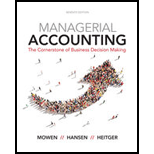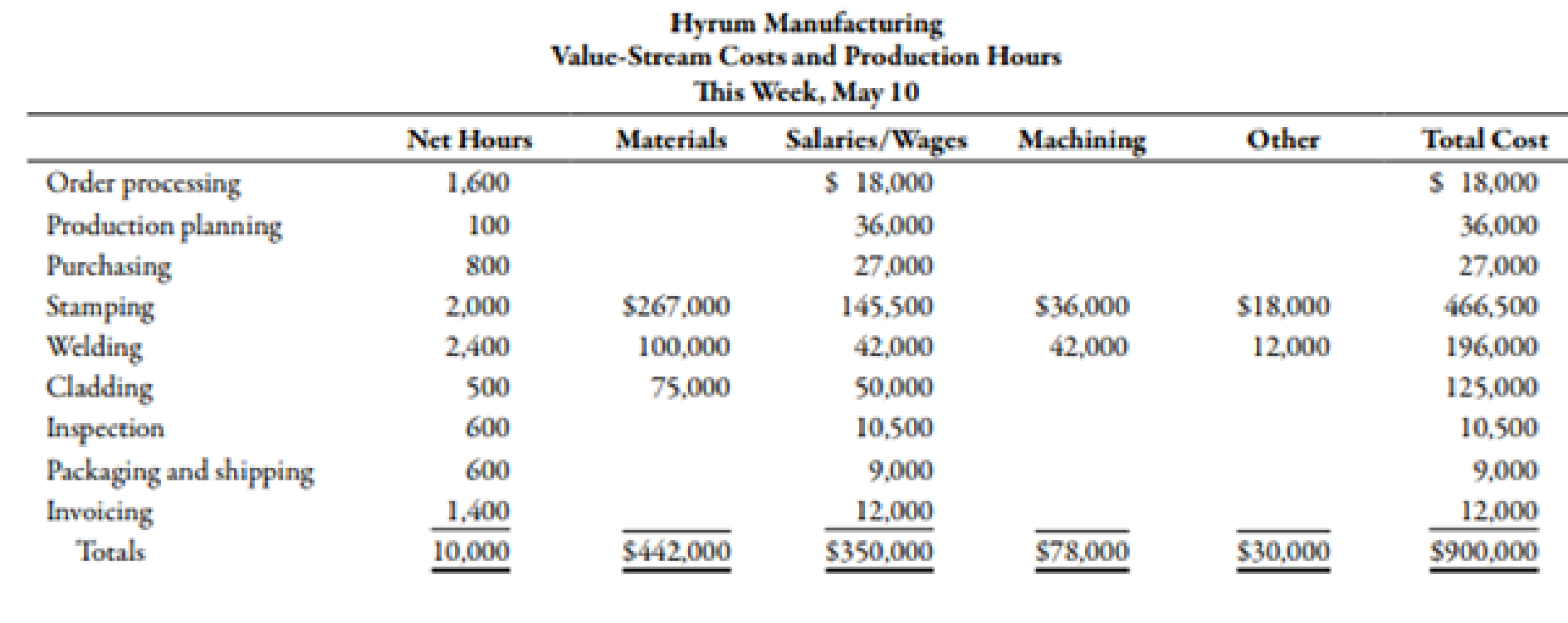
Concept explainers
During the week of May 10, Hyrum Manufacturing produced and shipped 16,000 units of its aluminum wheels: 4,000 units of Model A and 12,000 units of Model B. The cycle time for Model A is 1.09 hours and for Model B is 0.47 hour. The following costs and production hours were incurred:

Required:
- 1. Assume that the value-stream costs and total units shipped apply only to one model (a single-product value stream). Calculate the unit cost, and comment on its accuracy.
- 2. Assume that Model A is responsible for 40% of the materials cost. Calculate the unit cost for Models A and B, and comment on its accuracy. Explain the rationale for using units shipped instead of units produced in the calculation.
- 3. Calculate the unit cost for the two models, using DBC. Explain when and why this cost is more accurate than the unit cost calculated in Requirement 2.
1.
Compute unit cost assuming that the value-stream cost and total units shipped apply to a single model.
Answer to Problem 25BEA
Unit cost is $56.25
Explanation of Solution
Value Stream:
Value stream consists of the processes through which a product goes; that is from procurement to delivery. In value stream, all processes are covered whether or not they add value to the product.
Computation of unit cost:
Unit cost can be computed by using formula:
Substitute $900,000 for total value stream cost and 16,000 for total units in the above formula.
In case, there is only one product and all the costs are directly attributable to that product, then unit cost computed would provide accurate result.
Therefore, assuming that the value-stream cost and total units shipped apply to a single model, unit cost is $56.25
2.
Compute unit cost of both the models in case, Model A is responsible for 40% of the material cost. Comment on accuracy of the results and provide the rationale behind using units shipped instead of units produced.
Answer to Problem 25BEA
Unit cost of model A and B is $72.825 and $50.725 respectively.
Explanation of Solution
Computation of unit cost:
| Particulars | Model A ($) | Model B ($) |
| Units shipped | 4,000 | 12,000 |
| Material cost |
176,800 |
265,200 |
|
Material cost per unit (A) |
44.20 |
22.10 |
| Conversion cost per unit1 (B) | 28.625 | 28.625 |
| Unit cost | 72.825 | 50.725 |
Table (1)
Units shipped are used to compute per unit cost rather than units produced. This is done to encourage the reduction of goods produced, in excess of units to be shipped.
This would happen because value stream cost includes goods that are produced and unit cost would increase if goods shipped are lesser than goods produced.
Therefore, unit cost of model A and B is $72.825 and $50.725 respectively.
Working Notes:
1. Computation of conversion cost per unit:
3.
Compute unit cost for each model using duration based costing.
Answer to Problem 25BEA
Unit cost of model A and B would be $94.122 and $43.626 respectively.
Explanation of Solution
Duration Based Costing:
In duration based costing, value stream conversion cost is distributed amongst products in proportion of the cycle time.
Computation of unit cost:
| Particulars | Model A ($) | Model B ($) |
| Units shipped | 4,000 | 12,000 |
| Material cost |
176,800 |
265,200 |
|
Material cost per unit (A) |
44.20 |
22.10 |
| Conversion cost rate per hour1 | 45.8 | 45.8 |
| Cycle time per unit (hours) | 1.09 | 0.47 |
| Conversion cost per unit (B) |
49.922 |
21.526 |
| Unit cost | 94.122 | 43.626 |
Table (2)
Duration bond costing would provide better results when products are not homogeneous and time taken by each type of product varies.
Therefore, unit cost of model A and B would be $94.122 and $43.626 respectively.
Working Notes:
1. Computation of conversion cost rate:
Want to see more full solutions like this?
Chapter 13 Solutions
Managerial Accounting
- For questions 6 and 7, refer to the following information from the balance sheets and income statement of Pink Corp. From the balance sheets 12/31/2024 12/31/2023 Accounts receivable Prepaid insurance Machines Acc. depreciation $90,000 8,000 $80,000 From the income statement 12/31/2024 Sales $750,000 12,000 Cost of sales 65,000 95,000 Operating Expenses -600,000 -75,000 -30,000 -20,000 Gain on sale of machine 4,000 Additional information: Operating expenses includes depreciation expense Machines costing $30,000 were sold for $22,000 at a gain. 6) How much would net income be adjusted under the indirect method? A B $(12,000) $12,000 с D $0 $20,000 7) What were the cash payments for operating expenses under the direct method? A $74,000 C $61,000 B $49,000 D $53,000arrow_forwardNeed step by step answerarrow_forwardWhat was mark john's beginning capital balance?arrow_forward
- Financial Accountingarrow_forwardSolve this general accounting problem?arrow_forwardThe owner's equity at the beginning of the period for Vivo Enterprises was $52,000. At the end of the period, assets totaled $110,000, and liabilities were $28,000. If the owner made an additional investment of $12,000 and withdrew $9,000 during the period, what is the net income or (net loss) for the period?arrow_forward
 Managerial Accounting: The Cornerstone of Busines...AccountingISBN:9781337115773Author:Maryanne M. Mowen, Don R. Hansen, Dan L. HeitgerPublisher:Cengage Learning
Managerial Accounting: The Cornerstone of Busines...AccountingISBN:9781337115773Author:Maryanne M. Mowen, Don R. Hansen, Dan L. HeitgerPublisher:Cengage Learning Cornerstones of Cost Management (Cornerstones Ser...AccountingISBN:9781305970663Author:Don R. Hansen, Maryanne M. MowenPublisher:Cengage LearningPrinciples of Accounting Volume 2AccountingISBN:9781947172609Author:OpenStaxPublisher:OpenStax College
Cornerstones of Cost Management (Cornerstones Ser...AccountingISBN:9781305970663Author:Don R. Hansen, Maryanne M. MowenPublisher:Cengage LearningPrinciples of Accounting Volume 2AccountingISBN:9781947172609Author:OpenStaxPublisher:OpenStax College Managerial AccountingAccountingISBN:9781337912020Author:Carl Warren, Ph.d. Cma William B. TaylerPublisher:South-Western College Pub
Managerial AccountingAccountingISBN:9781337912020Author:Carl Warren, Ph.d. Cma William B. TaylerPublisher:South-Western College Pub



